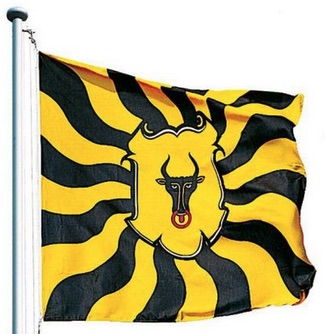![[Flag of Uri]](../images/c/ch-ur.gif) image by António Martins
image by António Martins

Last modified: 2025-11-08 by martin karner
Keywords: switzerland | uri | bull | german |
Links: FOTW homepage |
search |
disclaimer and copyright |
write us |
mirrors
Or, a bull's head caboshed sable, langued and noseringed gules.
On a yellow field, a black bull's head with no neck, seen face on, with a red tongue and a red nose ring.
That's the official part, but heraldic artists can take liberties beyond that. The inside of the bull's ears and
the outline of the eyes are sometimes rendered in red. Like all cantonal banners, this flag is derived from a war
flag and is square.
Pascal Gross, 19 June 2001
To illustrate the "liberties taken by the heraldic artists", this illustration comes from Achermann (1990).
Here the bull seems to have eaten a bit more and looks somewhat better this way. It contrasts with the more commonly seen
rather skinny shape of the bull's head, shown at the top of this page and known on a flag dating from the 15th century.
Pascal Gross, 19 June 2001
The black and yellow are taken from the black eagle on yellow field of the Holy Roman Empire, and the substitution
of a bull is perhaps a pun. The bull is actually an aurochs, a now extinct European bison, thought to have been plentiful
in Uri and domesticated by the locals (hence the nose ring). To the original Helvetes (Celts), the bull was a royal
symbol and a symbol of their god Cernunnos. Urners (people of Uri) have long been teased by other Swiss that the nose
ring signified they were wildmen who had to be tamed ("Ur" means wilderness, and Bos Urus is Latin for aurochs).
The ring was originally gold, meaning it was an "augmentation of honour" (According to legend, a pope granted this
honour for military services rendered).
T.F. Mills, 15 October 1997
The Uri flag is thought to have been in existence since at least 1231 when King Heinrich, son of Holy Roman Emperor
Friedrich II, granted the region "imperial freedom". This meant they were sovereign and owed no feudal allegiance
to anybody but the emperor and that they were entitled to their own flag. The flag was definitely carried at the battles
of Morgarten (1315) and Laupen (1339). A flag carried in those battles is preserved in the townhall of Altdorf.
T.F. Mills, 15 October 1997
The bull's head is called Uristier, meaning aurochs, Bos uris, which was domesticated by the original settlers.
The red ring was originally gold. Uri citizens have been teased that the the nose ring represents the fact that the people
of Uri had to be tamed. The bull has Celtic origins, representing royalty and a personification of the deity Cernunnos, who
bore stag antlers.
Source: Angst (1992), "A Panoply of Colours: The Cantonal
Banners of Switzerland and the Swiss National Flag"
Phil Nelson, 14 October 1998
The kind of depiction presented in the section "Variant of the Flag" on this page may be perceived as designed
only in 1990, which is not the case. This kind of naturalistic depiction of the aurochs (Uristier) is already presented
in the publication of the Federal Chancellery about the Swiss arms and control stamps from 1931
([c9h31], picture), and in
the 1942 flag book from Robert Mader ([mro42], picture).
They continued the tradition of more or less naturalistic depictions since the Middle Ages. In the second half of the 20th
century the image was simplified towards a more stylized depiction (picture). This
version is also used for the licence plates of vehicles. Around 1990 the newest version was introduced, which makes a reference
to the oldest Uri banners (e.g. to the banner of 1315, see below) (picture). Since 2012
this version is used for the logo of the cantonal authorities (picture,
source).
Martin Karner, 23 November 2023
![[Colour Flag UR]](../images/c/ch-ur_56.gif) image by Ole Andersen
image by Ole Andersen
Simple rectangular cantonal flag, as shown in Kannik (1956) [So-called colour flag (Farbenfahne in German)].
Ole Andersen, 4 August 2002
See also: STATE COLOURS in Dictionary of Vexillology
Flaggen, Knatterfahnen and Livery Colours | ||
![[Knatterfahnen]](../images/c/ch-ur_kf.gif) |
||
Flaggen are vertically hoisted from a crossbar in the manner of gonfanon, in ratio of about 2:9, with a swallowtail that indents about 2 units. The chief, or hoist (square part) usually incorporates the design from the coat of arms – not from the flag. The fly part is always divided lengthwise, usually in a bicolour, triband or tricolour pattern (except Schwyz which is monocolour, and Glarus which has four stripes of unequal width). The colours chosen for the fly end are usually the main colours of the coat of arms, but the choice is not always straight forward.
Knatterfahnen are similar to Flaggen, but hoisted from the long side and have no swallow tail. They normally show the national, cantonal or communal flag in their chiefs.
Željko Heimer, 16 July 2000
See also: HANGING FLAG, VERTICALLY HOISTED FLAG, LIVERY COLOURS in Dictionary of Vexillology

 images located by Martin Karner
images located by Martin Karner
At the beginning of the 20th century, flamed flags were still in use, with the white cross replaced by a (baroque) shield in the centre of the flag.
These decorative flags had been used until WWII and then somewhat forgotten in preference of the current cantonal flags. [Today they are being produced
again, see right image]
Pascal Gross, 30 June 2002
See also:
logo.jpg) image located by Martin Karner (8 May 2024)
image located by Martin Karner (8 May 2024) image located by Martin Karner
image located by Martin KarnerCockade for the cantonal troops' headgear (regulation from 1898, size: ca. 35 mm, reverse side).
Martin Karner, 14 March 2025
See also: Cockades (Swiss Army)